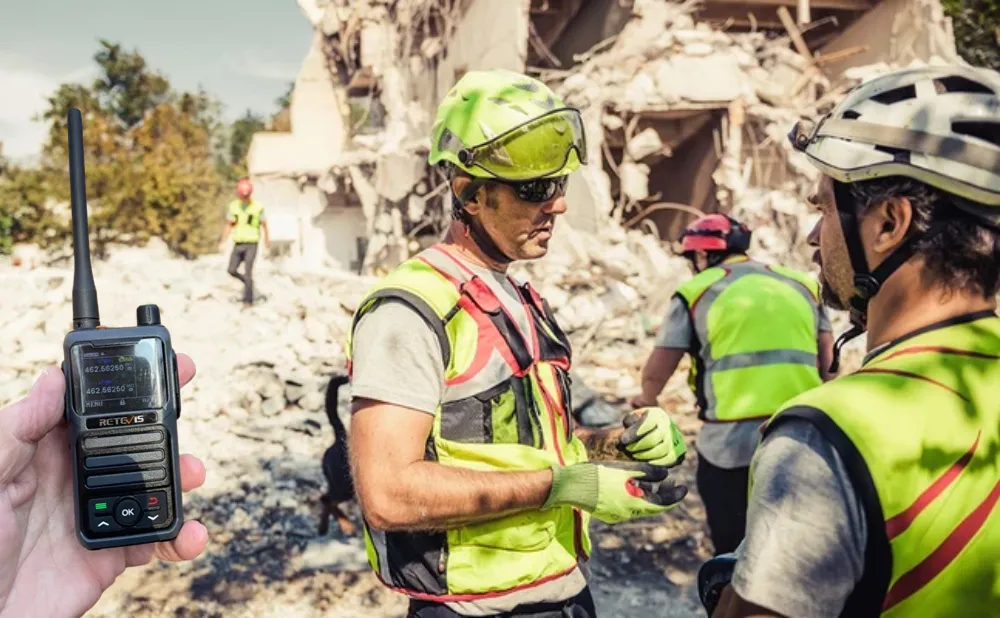Radio Repeater in Rescue Operations and City Security

Radio Repeater in Rescue Operations and City Security
For government agencies like police, fire departments, and rescue teams, having a dependable communication system is not just important—it's essential. Handheld two way radios are widely used in these sectors for their portability and efficiency, but their range can be limited, especially in large or challenging environments. This is where GMRS radio repeaters come into play, extending the reach of GMRS two way radios and ensuring seamless communication.
What is a Radio Repeater?
A radio repeater is a device that receives a signal from a handheld two way radio, amplifies it, and retransmits it, effectively extending the communication range. Repeaters can be strategically placed to cover large areas or difficult terrains, ensuring that communication remains clear and uninterrupted, even when direct line-of-sight between radios is not possible.
Key Functions of Radio Repeaters:
● Range Extension: By retransmitting signals, repeaters can cover distances far beyond the capability of handheld radios.
● Signal Amplification: Repeaters boost weak signals, ensuring that communication remains strong and clear.
● Continuous Coverage: They bridge communication gaps, providing coverage in areas that are dead zones for radio signals.
Enhancing Rescue Operations with Repeaters
In rescue operations, whether in urban environments, remote wilderness, or disaster-stricken areas, communication is often hampered by physical obstacles such as buildings, mountains, or severe weather conditions. Repeaters play a critical role in overcoming these challenges, enabling rescue teams to maintain contact with each other and command centers, regardless of the environment.
Known for the portability and cost-effectiveness, Retevis RT97S GMRS two way radio is always the first class. We would like to recommend this RT97S GMRS radio repeater with GMRS bundle for government agencies who need reliable communication in emergency.

Retevis RT97S GMRS Repeater with RB17P GMRS Radio Bundle
It includes an RT97S Portable GMRS Repeater Kit, which cover everything you need for a reliable repeater system, like an AC adapter and DC power cord, programming cable, omni-directional antenna, and 15-meter coaxial extender cable. The 10 packs of RB17P GMRS Radios can be assigned to each member in the rescue team. These radios feature NOAA weather alerts, a 2200mAh battery, a 1.7-inch TFT color screen, one-key to alarm, and more useful functions. RT97S GMRS radio base station can greatly help RB17P GMRS handhelds radio to reach a calling distance of 10 miles. The included microphones can ensure secure and seamless hands-free communication during work.
Example Scenario: Consider a search and rescue mission in a dense urban area following an earthquake. Buildings and debris may block direct radio signals, isolating rescue teams working in different areas. By deploying a portable RT97S repeater, agencies can ensure that RB17P GMRS handheld radios cover the whole coverage, allowing for coordinated efforts and faster response times.
Key Applications in City Security:
Emergency Response: During emergencies, repeaters help maintain clear communication across different units, whether they are on the ground or in vehicles, ensuring a swift and coordinated response.
Coverage of Complex Environments: In cities with high-rise buildings, tunnels, or large public gatherings, repeaters provide the necessary coverage to avoid dead zones and ensure uninterrupted communication.
Interagency Collaboration: Repeaters facilitate communication between different agencies, such as police, fire, and emergency medical services, ensuring that everyone is on the same page during joint operations.
Implementing Repeaters: Considerations for Government Agencies
While the benefits of using repeaters are clear, their successful implementation requires careful planning. Agencies must consider factors such as the specific communication needs of their operations, the geography of the area, and the technical specifications of the repeaters and handheld radios being used.
Steps to Effective Repeater Implementation:
1. Assess Communication Needs: Identify areas where communication is currently limited and determine the required range extension.
2. Site Selection: Choose optimal locations for repeater placement, considering factors such as elevation, proximity to critical areas, and potential obstacles.
3. Integration with Existing Systems: Ensure that repeaters are compatible with existing communication infrastructure and can seamlessly integrate into current operations.
4. Ongoing Maintenance: Regularly check and maintain repeaters to ensure they remain operational, particularly in areas subject to harsh conditions or high usage.
Thank you for reading this blog! If you have any questions, please leave your comments below. We are looking forward to your comments!
Related Blog: What Makes the Retevis RT97S Stand Out Among Other Radio Repeaters?






